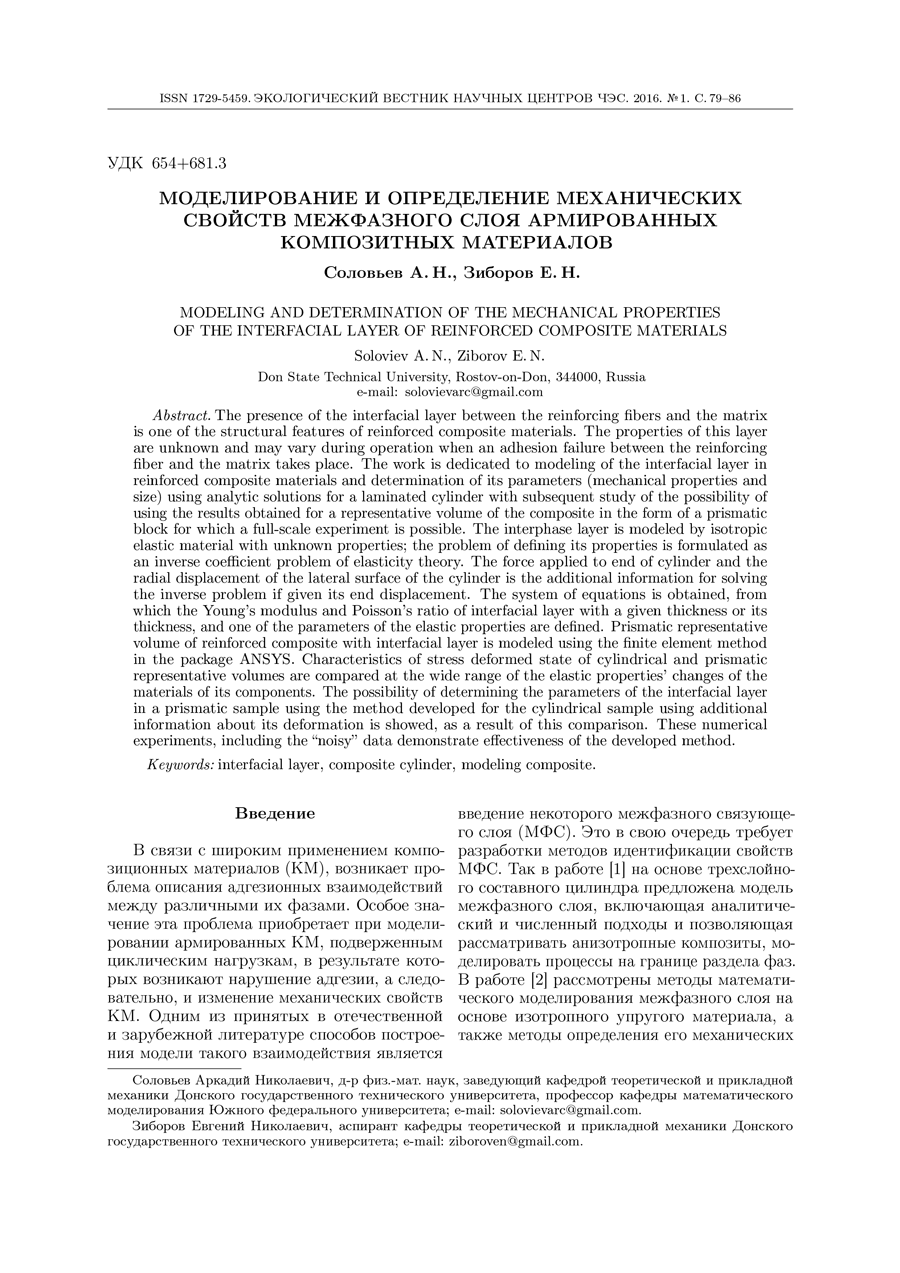Modeling and determination of the mechanical properties of the interfacial layer of reinforced composite materials
UDC
654+681.3Abstract
The presence of the interfacial layer between the reinforcing fibers and the matrix is one of the structural features of reinforced composite materials. The properties of this layer are unknown and may vary during operation when an adhesion failure between the reinforcing fiber and the matrix takes place. The work is dedicated to modeling of the interfacial layer in reinforced composite materials and determination of its parameters (mechanical properties and size) using analytic solutions for a laminated cylinder with subsequent study of the possibility of using the results obtained for a representative volume of the composite in the form of a prismatic block for which a full-scale experiment is possible. The interphase layer is modeled by isotropic elastic material with unknown properties; the problem of defining its properties is formulated as an inverse coefficient problem of elasticity theory. The force applied to end of cylinder and the radial displacement of the lateral surface of the cylinder is the additional information for solving the inverse problem if given its end displacement. The system of equations is obtained, from which the Young's modulus and Poisson's ratio of interfacial layer with a given thickness or its thickness, and one of the parameters of the elastic properties are defined. Prismatic representative volume of reinforced composite with interfacial layer is modeled using the finite element method in the package ANSYS. Characteristics of stress deformed state of cylindrical and prismatic representative volumes are compared at the wide range of the elastic properties’ changes of the materials of its components. The possibility of determining the parameters of the interfacial layer in a prismatic sample using the method developed for the cylindrical sample using additional information about its deformation is showed, as a result of this comparison. These numerical experiments, including the “noisy” data demonstrate effectiveness of the developed method.
Keywords:
interfacial layer, composite cylinder, modeling compositeReferences
- Novikov V.U., Burian O. Modelirovanie mezhfaznogo sloya v anizotropnykh kompozitakh [Modeling of the interfacial layer in anisotropic composites]. Prikladnaia fizika [Applied Physics], 2000, no. 1, pp. 11-15. (In Russian)
- Markin V.B., Tarasov A.V. Otsenka vyazko-uprugikh kharakteristik mezhfaznykh sloev i zakonomernost' ikh vliyaniya na mekhanicheskie svoystva polimernykh kompozitsionnykh materialov [Estimation of viscoelastic characteristics of the interfacial layers and regularity of their influence on the mechanical properties of polymer composites]. Trudy mezhdunarodnoy nauchno-tehnicheskoy konferencii "Kompozity v narodnom hoziaystve" [Proc. of the Int. Sci.-Tech. Conf. "Composites in the national economy"], Barnaul, Altai State Technical University, 1995, pp. 20-11. (In Russian)
- Nikishkov Y., Makeev A. Fatigue life assessment for composite materials. 18th International conference on composite material, 2011, Jeju Island, South Korea, pp. 119-120.
- Namin Jeong, David W. Rosen. A multi-scale model for the computer-aided design of polymer composites. 18th International conference on compositematerial, 2011, Jeju Island, South Korea, pp. 56-63.
- Zhou L., Kang Y., Guo J. Micromechanical modeling of double-walledcarbon nanotybe pullout from a matrix. 18th International conference on composite material, 2011, Jeju Island, South Korea, pp. 17-19.
- Obraztsov I.F., Lur'e S.A., Belov P.A., Volkov-Bogorodskiy D.B., Yanovskiy Yu.G., Kochemasova E.I., Dudchenko A.A., Potupchik E.M., Shumova N.P. Osnovy teorii mezhfaznogo sloya [Fundamentals of the theory of the interfacial layer], Mehanika kompozicionnyh materialov i konstrukciy [Mechanics of composite materials and structures], 2004. vol. 10, no. 4, pp. 596-612. (In Russian)
- Lurie S.A., Belov P.A., Modeling of the interphase layer in the mechanics of composite materials. Identification of the model parameters. Euromech Colloquium, no. 458, Lomonosov Moscow State University, 2004, pp. 72-74.
- Lurie S.A., Belov P.A. Mathematical model of the interfacial layer in the mechanics of materials. 6th International Congress on Mathematical Modeling, Nizhni Novgorod, 2004, pp. 19.
- Lurie S.A., Volkov-Bogorodsky D.B., Belov P.A., Tuchkova N.P. Multi-Scale Modeling of Interphase Layer in Mechanics of Heterogeneous Mediums. Euromech, S.-Petersburg (Repino), 2005, p. 59.
- Lurie S.A., Belov P.A. On Variant of Interphase Layer Theory. Abs. Int. Conf. "Advanced in Multiscale Modeling of Composite Materials Systems & Components", Monterey, 2005, pp. 55-57.
- Lurie S.A., Belov P.A., Volkov-Bogorodsky D. B., Tuchkova N.P. Interphase layer theory and application in the mechanics of composite materials. Computational Materials Science, 2006, vol. 41, no. 20, pp. 6693-6707.
- Patupchyk E.M., Lurie S.A., Belov P.A. Issledovanie adgezionnykh vzaimodeystviy v ramkakh neklassicheskikh modeley sploshnykh sred [Research adhesive interactions within non-classical models of continuous media] Tez. dokl. II Mezhdunar. Konf. "Deformatsiya i razrushenie materialov i nanomaterialov" [Abs. of the II International conf. "Deformation & Fracture of Materials and Nanomaterials"], Moscow, 2007, p. 10. (In Russian)
- Lurie S.A., Belov P.A., Sol J.O., Patupchyk E.M. Ob odnom variante kontinual'noy teorii adgezionnykh vzaimodeystviy [On a variant of the continuum theory of adhesive interactions]. Tez. dokl. II Mezhdunar. Konf. "Deformatsiya i razrushenie materialov i nanomaterialov" [Abs. of the II International conf. "Deformation & Fracture of Materials and Nanomaterials"], Moscow, 2007, p. 27. (In Russian)
- Belov P.A., Lurie S.A. Teoriya ideal'nykh adgezionnykh vzaimodeystviy [The theory of ideal adhesion interactions]. Mehanika kompozicionnyh materialov i konstrukciy [Mechanics of composite materials and structures], 2007, vol. 13, no. 4, pp. 519-536. (In Russian)
- Lure S.A., Belov P.A. Kontinual'naya teoriya adgezionnykh vzaimodeystviy povrezhdennykh sred [On a model of the adhesive properties in mechanics material]. Tez. dokl. I All-Russian Conf. "Mnogomasshtabnoe modelirovanie protsessov i struktur v nanotekhnologiyakh" [Abs. of the I All-Russian Conference "Multiscale modeling of processes and structures in nanotechnology"], 2008, pp. 193-195. (In Russian)
- Belov P.A., Lurie S.A. Kontinual'naya teoriya adgezionnykh vzaimodeystviy povrezhdennykh sred [The continuum theory of adhesive interactions damaged media]. Mekhanika kompozitsionnykh materialov i konstruktsiy [The mechanics of composite materials and designs], 2009, vol. 15, no. 4, pp. 610-629. (In Russian)
- Demidov S.P. Teoriya uprugosti [Theory of Elasticity]. Moskow, Vysshaya shkola Publ., 1979, 432 p. (in Russian)
Downloads
Issue
Pages
Submitted
Published
How to Cite
Copyright (c) 2016 Soloviev A.N., Ziborov E.N.

This work is licensed under a Creative Commons Attribution 4.0 International License.




